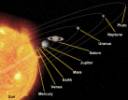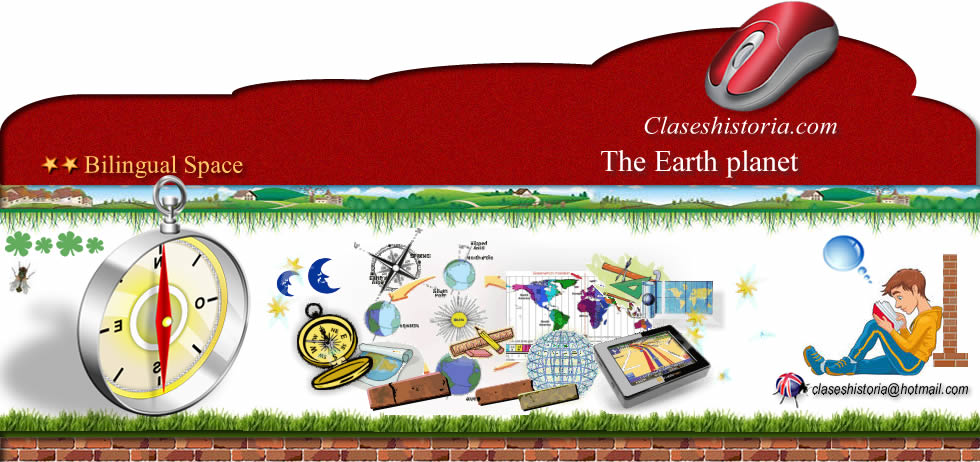1º de ESO Geography and History
 Unit THE EARTH PLANET- Index Unit THE EARTH PLANET- Index
THE EARTH
MOVEMENTS OF THE EARTH
GEOGRAPHIC NETWORK
REPRESENTATION OF THE EARTH
 MIND MAPS MIND MAPS
 GLOSSARY GLOSSARY
Equator
Tropic of Cancer
Tropic of Capricorn
Hemisphere
Equinox
Solstice
 EXERCISES EXERCISES
 LINKS LINKS
 KEYWORDS KEYWORDS
 USUAL PHRASES USUAL PHRASES
 Unit RELIEF Unit RELIEF
 Unit THE CLIMATE Unit THE CLIMATE
 Unit PREHISTORIC LIFE Unit PREHISTORIC LIFE
 Unit EGYPT Unit EGYPT
|
Bilingual Space  |
|
 Solar system
Solar system
Source: aerospaceweb.org |
The Earth is one of the planets of the solar system. It ranks third in proximity to the sun, which receives light and heat.
It is approximately 150 million of kilometres far from the sun. |
 Surface's distribution
Surface's distribution |
Water and land
Most of its surface is water (75%) and its divided between oceans, seas, rivers and lakes. The remaining 25% is land distributed between continents and islands. The Earth colour seen from the space is blue, due to the sea water.
|
Spherical in shape
The Earth planet is spherical in shape, but not perfect, as it is flattened by the poles.
An imaginary perpendicular line to the axis of the Earth, the Equator, divides it into two hemispheres: North and South.
|
|
A alive planet
The Earth is the only planet of the solar system where life exists. This is possible due to a number of factors:
 Terrestral radiation
Terrestral radiation |
-
Temperature: the Earth is far from the sun 150 million km, which allows life.
-
Atmosphere: covers the Earth from pernicious solar radiation, protecting it and allowing life on it.
-
Liquid water: essential for plants and animals.
|
 Liquid water
Liquid water |
 |
Ejercicio |
|
| |

Usamos cookies propias y de terceros que entre otras cosas recogen datos sobre sus hábitos de navegación para mostrarle publicidad personalizada y realizar análisis de uso de nuestro sitio.
Si continúa navegando consideramos que acepta su uso. OK Más información
© Jorge
Juan Lozano Cámara, profesor del IES
Juan de la Cierva de Vélez-Málaga
Licenciado por la Universidad de Granada (España) 
Ana María Marcos Sánchez, profesora del IES Juan de la Cierva de Vélez-Málaga
Licenciada por la Universidad de Málaga (España)
Kerry Elyse Hart, Licenciada por la Universidad de Richmond (Virginia, USA)
|
|

